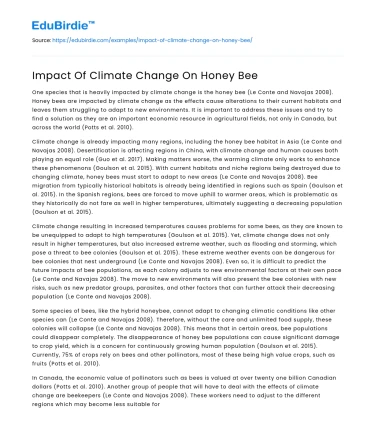One species that is heavily impacted by climate change is the honey bee (Le Conte and Navajas 2008). Honey bees are impacted by climate change as the effects cause alterations to their current habitats and leaves them struggling to adapt to new environments. It is important to address these issues and try to find a solution as they are an important economic resource in agricultural fields, not only in Canada, but across the world (Potts et al. 2010).
Climate change is already impacting many regions, including the honey bee habitat in Asia (Le Conte and Navajas 2008). Desertification is affecting regions in China, with climate change and human causes both playing an equal role (Guo et al. 2017). Making matters worse, the warming climate only works to enhance these phenomenons (Goulson et al. 2015). With current habitats and niche regions being destroyed due to changing climate, honey bees must start to adapt to new areas (Le Conte and Navajas 2008). Bee migration from typically historical habitats is already being identified in regions such as Spain (Goulson et al. 2015). In the Spanish regions, bees are forced to move uphill to warmer areas, which is problematic as they historically do not fare as well in higher temperatures, ultimately suggesting a decreasing population (Goulson et al. 2015).
Save your time!
We can take care of your essay
- Proper editing and formatting
- Free revision, title page, and bibliography
- Flexible prices and money-back guarantee
Climate change resulting in increased temperatures causes problems for some bees, as they are known to be unequipped to adapt to high temperatures (Goulson et al. 2015). Yet, climate change does not only result in higher temperatures, but also increased extreme weather, such as flooding and storming, which pose a threat to bee colonies (Goulson et al. 2015). These extreme weather events can be dangerous for bee colonies that nest underground (Le Conte and Navajas 2008). Even so, it is difficult to predict the future impacts of bee populations, as each colony adjusts to new environmental factors at their own pace (Le Conte and Navajas 2008). The move to new environments will also present the bee colonies with new risks, such as new predator groups, parasites, and other factors that can further attack their decreasing population (Le Conte and Navajas 2008).
Some species of bees, like the hybrid honeybee, cannot adapt to changing climatic conditions like other species can (Le Conte and Navajas 2008). Therefore, without the care and unlimited food supply, these colonies will collapse (Le Conte and Navajas 2008). This means that in certain areas, bee populations could disappear completely. The disappearance of honey bee populations can cause significant damage to crop yield, which is a concern for continuously growing human population (Goulson et al. 2015). Currently, 75% of crops rely on bees and other pollinators, most of these being high value crops, such as fruits (Potts et al. 2010).
In Canada, the economic value of pollinators such as bees is valued at over twenty one billion Canadian dollars (Potts et al. 2010). Another group of people that will have to deal with the effects of climate change are beekeepers (Le Conte and Navajas 2008). These workers need to adjust to the different regions which may become less suitable for beekeeping, and move on to other areas (Le Conte and Navajas 2008). This changing of regions means that beekeepers need to work to adapt their colonies to the new climate (Le Conte and Navajas 2008). Therefore, the health of bees and other pollinators is very important for the economy as they contribute greatly to its growth and stability. (Potts et al. 2010). On top of this, the crops they contribute to are even more important as they are a main food source for humans.
Overall, the most prominent impact of climate change on the bee population is the dispersion of the plants the bees rely on as a food source (Le Conte and Navajas 2008). Therefore, one way that we as a population can help the honey bees is to increase abundance of natural flower the bees rely on as a food source (Williams et al. 2015). Some governments are initiating projects to plant native wildflowers near agricultural land, which has provided a great benefit to local bee colonies, especially when planting a wide variety of species (Williams et al. 2015). The diversity of planted species allow for diversity in the honey bee’s diet (Goulson et al. 2015). This detail is important, as different pollens have differing nutrient contains, therefore a more diverse diet has been shown to improve the physical health of the bee (Goulson et al. 2015). In order to keep this species thriving, it is important to ensure the health of the plants they rely on for food.
References
- Conte, Y. L., & Navajas, M. (2008). Influencia de los cambios climáticos en las poblaciones de abejas y sus enfermedades. Revue Scientifique Et Technique De LOIE,27(2), 485-510. doi:10.20506/rst.27.2.1819
- Goulson, D., Nicholls, E., Botias, C., & Rotheray, E. L. (2015). Bee declines driven by combined stress from parasites, pesticides, and lack of flowers. Science,347(6229), 1255957-1255957. doi:10.1126/science.1255957
- Guo, Q., Fu, B., Shi, P., Cudahy, T., Zhang, J., & Xu, H. (2017). Satellite Monitoring the Spatial-Temporal Dynamics of Desertification in Response to Climate Change and Human Activities across the Ordos Plateau, China. Remote Sensing,9(6), 525. doi:10.3390/rs9060525
- Potts, S. G., Biesmeijer, J. C., Kremen, C., Neumann, P., Schweiger, O., & Kunin, W. E. (2010). Global pollinator declines: Trends, impacts and drivers. Trends in Ecology & Evolution,25(6), 345-353. doi:10.1016/j.tree.2010.01.007
- Williams, N. M., Ward, K. L., Pope, N., Isaacs, R., Wilson, J., May, E. A., . . . Peters, J. (2015). Native wildflower plantings support wild bee abundance and diversity in agricultural landscapes across the United States. Ecological Applications,25(8), 2119-2131. doi:10.1890/14-1748.1






 Stuck on your essay?
Stuck on your essay?

